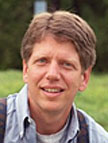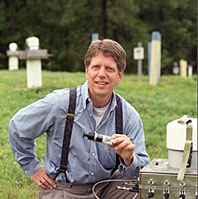| Research
|
The Citizens for Nuclear Technology Awareness, a South Carolina-Georgia based group that provides information about the benefits and risks of nuclear technologies, has honored Savannah River National Laboratory 's Dr. Brian B. Looney for his trend-setting work in environmental remediation. CNTA named Dr. Looney its Fred C. Davison Distinguished Scientist of the Year Award recipient for 2006. Dr. Looney is a Senior Advisory Engineer in the Environmental Sciences and Technology Department of SRNL. He is recognized both nationally and internationally for his technical expertise, leadership, and scientific contributions in environmental remediation, site characterization, contaminant geochemistry and modeling. In all elements of his work, Dr. Looney stresses the use of natural forces and processes for environmental cleanup to minimize additional disruption to the environment. He has been a leader in this new scientific direction of green chemistry and environmental sustainability, ideals that are becoming more mainstream. Dr. Looney works directly with key stakeholders to establish and maintain the integrity of projects by developing innovative, cost-effective, and non-intrusive solutions to complex subsurface science issues, such as the investigation of benzene contamination or the assessment and cleanup of dense non-aqueous phase liquids. Dr. Looney is a skilled presenter of complex technical material and is frequently requested to present at national conferences, seminars, and meetings to gain support for deployment of innovative technologies. Dr. Looney traveled to Russia to work with Russian scientists applying SRNL-developed environmental technologies to the cleanup of contaminated sites in the former Soviet Union. Dr. Looney has numerous publications; is active in national technical societies; holds eight patents for environmental technologies; and has received numerous awards. He is the recipient of two R&D 100 Awards for his work in techniques related to bioremediation; one for development and commercialization of In situ Bioremediation of Chlorinated Solvents with Natural Gas and the other for PHOSter™ system for applying phosphorus to accelerate bioremediation. Submitted by DOE's Savannah River National Laboratory |
|||||||||||||||||||||||
|
Check out the Office of Science's new Website.
|
Neutrino experiment for
|
 |
Daya Bay (click image for larger view.) |
"Neutrinos are very hot right now," said Brookhaven National Laboratory physicist Laurence Littenberg, a Daya Bay collaborator. "It was only in the last decade that we learned they have mass, and there's still so much that we don't know about them."
Uncharged elementary particles produced naturally from the sun and cosmic rays, neutrinos morph, or oscillate, among three flavors — electron, muon, and tau — as they travel through space, people, buildings, and even Earth itself, interacting only rarely. Scientists have characterized two of these oscillations in detail, and are seeking to measure details of the third. The Daya Bay project is poised to measure an important property of this oscillation, possibly helping scientists gain a better understanding of the early history of the universe.
One of the most perplexing questions has to do with the matter that makes up the universe — and everything and everyone in it. The Big Bang should have created equal amounts of matter and antimatter, which would have annihilated each other. Yet today, the universe is almost entirely matter. Some scientists believe that this puzzling phenomenon is tied to the properties of neutrinos.
"At the moment, we don't know why the universe is dominated only with matter," said Lawrence Berkeley National Laboratory physicist Kam-Biu Luk, one of two scientific spokesmen for the Daya Bay project. "It's the reason that everyone and everything exists. This is very exciting and important, and I would love to be part of the team that finds out why we are here."
The Daya Bay experiment would look for the third type of neutrino oscillation by studying antineutrinos produced in nuclear reactions at a power station containing a cluster of several reactors in southern China. Detectors described as "liquid onions," because of their layered design, will sit beneath granite mountains at different distances from the reactors. Scientists will compare the number of electron antineutrinos produced in the reactors and the number expected to arrive at each detector to how many events are actually detected to get a measure important for understanding this oscillation.
The U.S. and China will share leadership and responsibilities for Daya Bay. "The U.S. and China have been trying to get more and more scientific exchanges between them, and this is another step in that direction," says Randy Johnson, DOE's program director for the Daya Bay project.
The project leaders hope to pass through a series of critical decision steps as quickly as possible to start construction in 2007, with data collection beginning in 2010.
Submitted by DOE's Brookhaven National Laboratory


